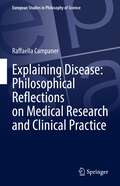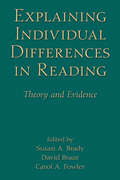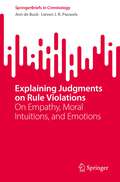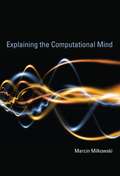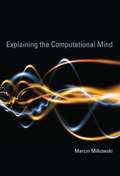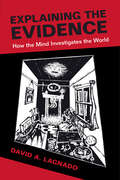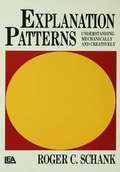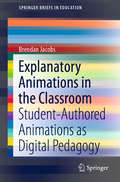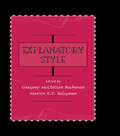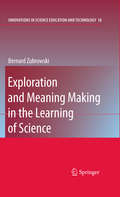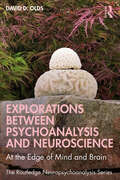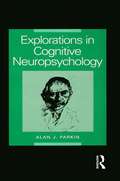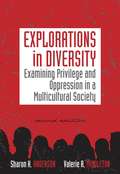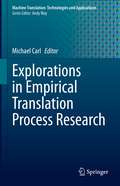- Table View
- List View
Explaining Creativity: The Science of Human Innovation
by R. Keith Sawyer<p>Explaining Creativity is an accessible introduction to the latest scientific research on creativity. The book summarizes and integrates a broad range of research in psychology and related scientific fields. In the last 40 years, psychologists, anthropologists, and sociologists have devoted increased attention to creativity; we now know more about creativity than at any point in history. Explaining Creativity considers not only arts like painting and writing, but also science, stage performance, business innovation, and creativity in everyday life. <p>Sawyer's approach is interdisciplinary. In addition to examining psychological studies on creativity, he draws on anthropologists' research on creativity in non-Western cultures, sociologists' research on the situations, contexts, and networks of creative activity, and cognitive neuroscientists' studies of the brain. He moves beyond the individual to consider the social and cultural contexts of creativity, including the role of collaboration in the creative process.</p>
Explaining Disease: Philosophical Reflections on Medical Research and Clinical Practice (European Studies in Philosophy of Science)
by Raffaella CampanerThis interdisciplinary monograph in philosophy of medicine examines models of explanation in health science and their relation with current medical trends, such as personalized and person-centered medicine. Medicine has provided challenging case studies for the general philosophy of science that have prompted rethinking of a wide range of philosophical notions – such as scientific law, theory and evidence – and contributed to the elaboration of pluralistic approaches to modeling, causality and explanation. The health sciences have increasingly recognized the role of philosophy of medicine as both a field of conceptual and methodological reflection, capable of addressing practical issues, and hence relevant for a proper understanding of the construction of medical knowledge, modeling practices, therapeutic strategies and preventive decisions.'Explaining Disease' contains various case studies in medicine to describe the assumptions underpinning the construction of explanatory models of diseases. It shows the impact different explanatory strategies can have on practical matters, which in turn affect clinical evaluation and therapy and public health decisions. The book concludes with a few open-ended reflections to foster more thorough consideration of the role of philosophy of medicine can play its dialogue with the health sciences. [this sounds wrong. Either: of the role of philosophy of medicine in its dialogue with the sciences, or: of the role philosophy of medicine can play in its dialogue with the health sciences.
Explaining Individual Differences in Reading: Theory and Evidence (New Directions in Communication Disorders Research)
by Susan A. Brady David Braze Carol A. FowlerResearch into reading development and reading disabilities has been dominated by phonologically guided theories for several decades. In this volume, the authors of 11 chapters report on a wide array of current research topics, examining the scope, limits and implications of a phonological theory. The chapters are organized in four sections. The first concerns the nature of the relations between script and speech that make reading possible, considering how different theories of phonology may illuminate the implication of these relations for reading development and skill. The second set of chapters focuses on phonological factors in reading acquisition that pertain to early language development, effects of dialect, the role of instruction, and orthographic learning. The third section identifies factors beyond the phonological that may influence success in learning to read by examining cognitive limitations that are sometimes co-morbid with reading disabilities, contrasting the profiles of specific language impairment and dyslexia, and considering the impact of particular languages and orthographies on language acquisition. Finally, in the fourth section, behavioral-genetic and neurological methods are used to further develop explanations of reading differences and early literacy development. The volume is an essential resource for researchers interested in the cognitive foundations of reading and literacy, language and communication disorders, or psycholinguistics; and those working in reading disabilities, learning disabilities, special education, and the teaching of reading.
Explaining Judgments on Rule Violations: On Empathy, Moral Intuitions, and Emotions (SpringerBriefs in Criminology)
by Ann de Buck Lieven J. PauwelsThis volume highlights the complex relations between empathy, individualizing and groupish moral intuitions, (anticipated) moral emotions, and moral judgment. It is rooted in the notion that human moral systems were not immune to evolutionary processes and thus shaped by biological and cultural evolutionary forces (e.g. natural selection, genetic drift, mutation, sexual selection, cultural mutation, ecological selection pressures, etc.). This edition proposes a conceptual model of both distal and proximal variables to integrate insights from Moral Foundations Theory with theorizing on commitment strategies by linking empathy and moral intuitions to moral emotions (guilt, anger, disgust), and moral judgment in the context of distinct moral violations. The proposed model is tested using data from a convenience sample of young adults in Belgium, who responded to written hypothetical scenarios in a large-scale online survey. This volume is ideal for moral theory researchers in criminology, psychology, and related disciplines
Explaining Psychological Statistics
by Barry H. CohenPraise for the previous edition of Explaining Psychological Statistics"I teach a master's level, one-semester statistics course, and it is a challenge to find a textbook that is at the right level. Barry Cohen's book is the best one I have found. . . . I like the fact that the chapters have different sections that allow the professor to decide how much depth of coverage to include in his/her course. . . . This is a strong and improved edition of an already good book." -Karen Caplovitz Barrett, PhD, Professor, and Assistant Department Head of Human Development and Family Studies, Colorado State University"The quality is uniformly good. . . . This is not the first statistics text I have read but it is one of the best." -Michael Dosch, PhD, MS, CRNA, Associate Professor and Chair, Nurse Anesthesia, University of Detroit MercyA clear and accessible statistics text- now fully updated and revisedNow with a new chapter showing students how to apply the right test in the right way to yield the most accurate and true result, Explaining Psychological Statistics, Fourth Edition offers students an engaging introduction to the field. Presenting the material in a logically flowing, non-intimidating way, this comprehensive text covers both introductory and advanced topics in statistics, from the basic concepts (and limitations) of null hypothesis testing to mixed-design ANOVA and multiple regression.The Fourth Edition covers:Basic statistical proceduresFrequency tables, graphs, and distributionsMeasures of central tendency and variabilityOne- and two-sample hypothesis testsHypothesis testingInterval estimation and the t distribution
Explaining Social Behavior
by Jon ElsterIn this new edition of his critically acclaimed book, Jon Elster examines the nature of social behavior, proposing choice as the central concept of the social sciences. Extensively revised throughout, the book offers an overview of key explanatory mechanisms, drawing on many case studies and experiments to explore the nature of explanation in the social sciences; an analysis of the mental states - beliefs, desires, and emotions - that are precursors to action; a systematic comparison of rational-choice models of behavior with alternative accounts, and a review of mechanisms of social interaction ranging from strategic behavior to collective decision making. A wholly new chapter includes an exploration of classical moralists and Proust in charting mental mechanisms operating 'behind the back' of the agent, and a new conclusion points to the pitfalls and fallacies in current ways of doing social science, proposing guidelines for more modest and more robust procedures.
Explaining the Computational Mind
by Marcin MilkowskiIn this book, Marcin Milkowski argues that the mind can be explained computationally because it is itself computational -- whether it engages in mental arithmetic, parses natural language, or processes the auditory signals that allow us to experience music. Defending the computational explanation against objections to it -- from John Searle and Hilary Putnam in particular -- Milkowski writes that computationalism is here to stay but is not what many have taken it to be. It does not, for example, rely on a Cartesian gulf between software and hardware, or mind and brain. Milkowski's mechanistic construal of computation allows him to show that no purely computational explanation of a physical process will ever be complete. Computationalism is only plausible, he argues, if you also accept explanatory pluralism. Milkowski sketches a mechanistic theory of implementation of computation against a background of extant conceptions, describing four dissimilar computational models of cognition. He reviews other philosophical accounts of implementation and computational explanation and defends a notion of representation that is compatible with his mechanistic account and adequate vis à vis the four models discussed earlier. Instead of arguing that there is no computation without representation, he inverts the slogan and shows that there is no representation without computation -- but explains that representation goes beyond purely computational considerations. Milkowski's arguments succeed in vindicating computational explanation in a novel way by relying on mechanistic theory of science and interventionist theory of causation.
Explaining the Computational Mind
by Marcin MilkowskiA defense of the computational explanation of cognition that relies on mechanistic philosophy of science and advocates for explanatory pluralism. In this book, Marcin Milkowski argues that the mind can be explained computationally because it is itself computational—whether it engages in mental arithmetic, parses natural language, or processes the auditory signals that allow us to experience music. Defending the computational explanation against objections to it—from John Searle and Hilary Putnam in particular—Milkowski writes that computationalism is here to stay but is not what many have taken it to be. It does not, for example, rely on a Cartesian gulf between software and hardware, or mind and brain. Milkowski's mechanistic construal of computation allows him to show that no purely computational explanation of a physical process will ever be complete. Computationalism is only plausible, he argues, if you also accept explanatory pluralism.Milkowski sketches a mechanistic theory of implementation of computation against a background of extant conceptions, describing four dissimilar computational models of cognition. He reviews other philosophical accounts of implementation and computational explanation and defends a notion of representation that is compatible with his mechanistic account and adequate vis à vis the four models discussed earlier. Instead of arguing that there is no computation without representation, he inverts the slogan and shows that there is no representation without computation—but explains that representation goes beyond purely computational considerations. Milkowski's arguments succeed in vindicating computational explanation in a novel way by relying on mechanistic theory of science and interventionist theory of causation.
Explaining the Evidence: How the Mind Investigates the World
by David A. LagnadoHow do we make sense of complex evidence? What are the cognitive principles that allow detectives to solve crimes, and lay people to puzzle out everyday problems? To address these questions, David Lagnado presents a novel perspective on human reasoning. At heart, we are causal thinkers driven to explain the myriad ways in which people behave and interact. We build mental models of the world, enabling us to infer patterns of cause and effect, linking words to deeds, actions to effects, and crimes to evidence. But building models is not enough; we need to evaluate these models against evidence, and we often struggle with this task. We have a knack for explaining, but less skill at evaluating. Fortunately, we can improve our reasoning by reflecting on inferential practices and using formal tools. This book presents a system of rational inference that helps us evaluate our models and make sounder judgments.
Explanation Patterns: Understanding Mechanically and Creatively
by R. P. SchankFirst Published in 1986. Routledge is an imprint of Taylor & Francis, an informa company.
Explanatory Animations in the Classroom: Student-Authored Animations as Digital Pedagogy (SpringerBriefs in Education)
by Brendan JacobsThis book provides groundbreaking evidence demonstrating how student-authored explanatory animations can embody and document learning as an exciting new development within digital pedagogy. Explanatory animations can be an excellent resource for teaching and learning but there has been an underlying assumption that students are predominately viewers rather than animation authors. The methodology detailed in this book reverses this scenario by putting students in the driver’s seat of their own learning. This signals not just a change in perspective, but a complete change in activity that, to continue the analogy, will forever change the conversation and make redundant phrases like “Are we there yet?” and “How much longer?” The digital nature of such practices provides compelling evidence for reconceptualising explanatory animation creation as a pedagogical activity that generates multimodal assessment data. Tying together related themes to advance approaches to evidence-based assessment using digital technologies, this book is intended for educators at any stage of their journey, including pre-service teachers.
Explanatory Models, Unit Standards, and Personalized Learning in Educational Measurement: Selected Papers by A. Jackson Stenner
by William P. Fisher Paula J. MassengillThe papers by Jack Stenner included in this book document the technical details of an art and science of measurement that creates new entrepreneurial business opportunities. Jack brought theory, instruments, and data together in ways that are applicable not only in the context of a given test of reading or mathematics ability, but which more importantly catalyzed literacy and numeracy capital in new fungible expressions. Though Jack did not reflect in writing on the inferential, constructive processes in which he engaged, much can be learned by reviewing his work with his accomplishments in mind. A Foreword by Stenner's colleague and co-author on multiple works, William P. Fisher, Jr., provides key clues concerning (a) how Jack's understanding of measurement and its values aligns with social and historical studies of science and technology, and (b) how recent developments in collaborations of psychometricians and metrologists are building on and expanding Jack's accomplishments. This is an open access book.
Explanatory Style
by Martin E. P. Seligman Gregory McClellan BuchananThis is the first work to condense the large literature on explanatory style -- one's tendency to offer similar sorts of explanations for different events. This cognitive variable has been related to psychopathology, physical health, achievement and success. Compiled by experts in the fields of depression, anxiety, psychoneuroimmunology and motivation, this volume details our current level of understanding, outlines gaps in our knowledge, and discusses the future directions of the field. Data from a vast number of studies are presented, including results from studies not previously reported. Coverage includes sections on cross-cultural comparisons, life-span and development issues, and gender differences; and an extensive description of the measurement of explanatory style offering questionnaire and content-analysis methods for children, college populations and adults. This work is thus a valuable tool for anyone involved in research on the etiology and treatment of depression, cognitive therapy, motivation and emotion, and the link between physical and psychological well-being.
Explanatory Style
by Martin E. P. Seligman Gregory McClellan BuchananThis is the first work to condense the large literature on explanatory style -- one's tendency to offer similar sorts of explanations for different events. This cognitive variable has been related to psychopathology, physical health, achievement and success. Compiled by experts in the fields of depression, anxiety, psychoneuroimmunology and motivation, this volume details our current level of understanding, outlines gaps in our knowledge, and discusses the future directions of the field. Data from a vast number of studies are presented, including results from studies not previously reported. Coverage includes sections on cross-cultural comparisons, life-span and development issues, and gender differences; and an extensive description of the measurement of explanatory style offering questionnaire and content-analysis methods for children, college populations and adults. This work is thus a valuable tool for anyone involved in research on the etiology and treatment of depression, cognitive therapy, motivation and emotion, and the link between physical and psychological well-being.
Explicit and Implicit Prosody in Sentence Processing
by Lyn Frazier Edward GibsonTop researchers in prosody and psycholinguistics present their research and their views on the role of prosody in processing speech and also its role in reading. The volume characterizes the state of the art in an important area of psycholinguistics. How are general constraints on prosody ('timing') and intonation ('melody') used to constrain the parsing and interpretation of spoken language? How are they used to assign a default prosody/intonation in silent reading, and more generally what is the role of phonology in reading? Prosody and intonation interact with phonology, syntax, semantics and pragmatics and thus are at the very core of language processes.
Exploding Steamboats, Senate Debates, and Technical Reports: The Convergence of Technology, Politics, and Rhetoric in the Steamboat Bill of 1838 (Baywood's Technical Communications)
by R. John BrockmannBy 1838, over two thousand Americans had been killed and many hundreds injured by exploding steam engines on steamboats. After calls for a solution in two State of the Union addresses, a Senate Select Committee met to consider an investigative report from the Franklin Institute of Philadelphia, the first federally funded investigation into a technical.
Exploding Technical Communication: Workplace Literacy Hierarchies and Their Implications for Literacy Sponsorship (Baywood's Technical Communications)
by Charles H. Sides Remley DirkWithin the framework of New Literacy Studies, Dirk Remley presents a historical study of how technical communication practices at a World War II arsenal sponsored literacy within the community in which it operated from 1940 to 1960 and contemporary implications of similar forms of sponsorship. The Training within Industry (TWI) methods developed by the U.S. government and industry at that time included multimodal literate practices, particularly combinations of visual, oral, experiential, and print-linguistic text. Analyses reveal a hierarchy in which print-linguistic literacies were generally esteemed at the workplace and in the community. This literacy hierarchy contributed to a catastrophic accident that killed 11 people, prompting changes in the approach to designing certain training documents. This book links technical communication, especially the multimodal forms of representation commonly found in technical communication and instructional materials, to the concept of literacy sponsorship. The TWI methods used in training and system improvement during World War II are currently applied in business and industry as part of the "lean operating" and "continuous improvement" philosophies. These methods have also become part of the experiential learning philosophy favored in academia. Remley includes examples of current applications of multimodal forms of technical communication similar to those used at the arsenal as well as new media-related applications related to training and instruction. He also discusses their implications for literacy sponsorship. This book provides useful information for technical communication and literacy scholars and educators as well as practical case studies for business leaders, consultants, and practitioners. Intended Audience: Scholars in technical communication and literacy/writing studies; scholars in business (especially management and organizational analysis) and business communication consultants; scholars in history and sociology.
Exploration and Meaning Making in the Learning of Science
by Bernard ZubrowskiThis book provides a broad and deep rationale for various pedagogical practices associated with the teaching of science. The main thesis of this book is that the exploratory phase of scientific inquiry is undervalued and its purpose misunderstood. Furthermore, there is a need for an expanded conception or alternative way of thinking about the so called learning cycle that has been frequently cited as the pedagogical model for a fair number of curriculum programs. A pedagogical model is proposed that recognizes learning cycles as ones that build on each other in an in-depth developmental manner. It presents an alternative paradigm that gives more attention to the motivation of students and assigns an essential role for student input. The overall goal is to move the reader to think more holistically about the practice of science education. This original and unorthodox book summarizes the author's present thinking about curriculum design and direct work with students. The author draws upon his varied experiences to present a case for the importance of direct engagement with phenomena and materials. He argues that this practice is more than a matter of motivating students to become engaged in inquiry. The first four chapters lay out different levels of a pedagogical approach and an overall theoretical orientation. The middle chapters focus on what might be called sensory knowledge. These are concerned with the role of different sensory engagement, movement as related to gestural representation and the role of empathy in exploration. The last four chapters are about the role of aesthetic, play, variable exploration and metaphor in their shaping of science education experiences. Each chapter is introduced with a scenario or case study describing the behavior and talk of elementary or middle school students. The intention of these scenarios is to help the reader stay grounded while considering the more abstract development of research reports and broader philosophical issues.
Explorations Between Psychoanalysis and Neuroscience: At the Edge of Mind and Brain (The Routledge Neuropsychoanalysis Series)
by David D. OldsExplorations Between Psychoanalysis and Neuroscience brings together the life's work of David Olds, pioneering psychoanalyst, psychiatrist, philosopher, and key figure in neuropsychoanalysis.Throughout the chapters, the reader is taken on a journey through Olds' theories on psychoanalysis and neuroscience as he develops new ways of examining the brain and human thought. Olds instills in the reader the importance of taking an interdisciplinary approach to psychoanalysis, psychiatry and working with patients. He expands upon his philosophical background and integrates evolutionary biology, neurobiology, cognitive science and semiotics to show the importance of dual aspect monism in neuropsychoanalysis. The theories developed by Olds and presented in this volume will help analysts working with patients facing issues with memory, affect, consciousness, cognition and trauma, among other difficulties.This book will be essential reading to psychoanalysts and psychiatrists, as well as anybody interested in neuropsychoanalysis and the importance of an interdisciplinary approach to analytic thinking and practice.
Explorations in Autism: A Psychoanalytical Study
by Donald MeltzerExplorations in Autism is a turning-point in both the understanding of and the clinical approach to autism. The clinical material gradually unveils the geography of the internal mother (which proved crucial for the development of Meltzer's 'claustrum' theory) and allowed him to draft, for the first time in psychoanalysis, a theory of the dimensionality of mental life
Explorations in Bion's 'O': Everything We Know Nothing About (The Routledge Wilfred R. Bion Studies Book Series)
by Afsaneh K. Alisobhani Glenda J. CorstorphineWilfred Bion described "O" as "the unknowable and the unreachable ultimate truth". In this fascinating collection, a range of authors offer their own theoretical, clinical and artistic approaches to exploring this enduring but mysterious idea. <P><P>Drawn from contributions from the 8th International Bion Conference in 2014, the book examines how "O" can be experienced in all aspects of internal and external reality and within all relationships, from an individual relating to the mother to their emotional relationship with their self. It features insights into "O" drawn from the area of faith as well as its manifestations in clinical practice, while also included is a chapter exploring the links between Bion’s ideas and those of Winnicott, Lacan, Green and Freud. <P><P>Featuring contributions from some of the world’s leading Bion scholars, this will be essential reading for any psychoanalyst interested in exploring the concept of "O", as well as scholars in philosophy and theology.
Explorations in Cognitive Neuropsychology
by Alan ParkinCognitive neuropsychology has now established a major place in the teaching of undergraduate psychology degrees and is an important topic of postgraduate research. The subject is also of increasing interest to clinicians because of its links with devising remediation procedures for people with brain injury. Explorations in Cognitive Neuropsychology is the first major text to appear on this topic since the late 1980s and thus introduces the reader to a vast amount of research previously unavailable in textbook format. The book is written in a lively and engaging style which nonetheless enables the reader to get a scholarly, in-depth overview of this important field. The coverage of topics is very broad-ranging. It begins with an overview of the subject including issues such as research strategy and advances in neuroimaging. Following this are chapters on blindsight, agnosia, facial processing impairments, and the rapidly growing area of neglect. The next chapter is devoted to studies of the split brain. Two chapters then cover the enormous developments in devising functional architectures of the language system from the observation of discrete language impairments. Various aspects of memory impairments are then discussed and the book ends with a consideration of frontal lobe functions. At various points the book also covers the contribution of connectionist modelling to cognitive neuropsychology.
Explorations in Diversity: Examining Privilege and Oppression In A Multicultural Society (Second Edition)
by Sharon K. Anderson Valerie A. MiddletonThis unique text features personal accounts from mental health professionals, professors and students facing issues of privilege and oppression in our diverse society. In this collection of articles, writers discuss discoveries and experiences about their own privileges and oppression, and ultimately, the compassion they've developed for individuals confronted with discrimination. Each essay will inspire you to reflect on your own encounters with privilege and oppression, while discussion questions at the end of each story provide an opportunity to process these issues on a personal level. By studying these revealing stories of insight and understanding, you'll learn how to recognize, examine, and finally, come to terms with your own privileges and discrimination -- allowing you to become a stronger, more acute, and more effective practitioner of the helping professions.
Explorations in Dynamic Semiosis (Theory and History in the Human and Social Sciences)
by Elli Marie TragelThis anthology is a manifold combining semiotics and psychology. Chapters in the book are authored by young scholars making sense of semiosis in irreversible time from a multitude of perspectives. The central focus on the dynamics of meaning-making comes together in a variety of topics that align in the core idea of dynamic nature of human making and use of signs. First, this book gives a comprehensive overview of relational dynamics of the sign. The overview is followed by a collection of chapters focusing on various topics relevant for humanities and social sciences, such as experience of time, (cultural) memory, musical signification, human-computer interactions, death and eternity, freedom and responsibility, authenticity, methods for practice and research in psychology, etc. This anthology contributes to the integration of the fields of semiotics and psychology, building on the classic traditions of the Tartu-Moscow School of Semiotics (established by Juri Lotman) and contemporary cultural psychology that has unified social sciences in the recent three decades. Examples of how new semiotic models are applied to various domains of human lives will be given, anticipating the future and addressing its past. As such, this book is a relevant read for everyone interested in the complex nature of meaning-making, and inclusion of dynamics in all expressions of life, including academic research.
Explorations in Empirical Translation Process Research (Machine Translation: Technologies and Applications #3)
by Michael CarlThis book assembles fifteen original, interdisciplinary research chapters that explore methodological and conceptual considerations as well as user and usage studies to elucidate the relation between the translation product and translation/post-editing processes. It introduces numerous innovative empirical/data-driven measures as well as novel classification schemes and taxonomies to investigate and quantify the relation between translation quality and translation effort in from-scratch translation, machine translation post-editing and computer-assisted audiovisual translation. The volume addresses questions in the translation of cognates, neologisms, metaphors, and idioms, as well as figurative and cultural specific expressions. It re-assesses the notion of translation universals and translation literality, elaborates on the definition of translation units and syntactic equivalence, and investigates the impact of translation ambiguity and translation entropy. The results and findings are interpreted in the context of psycho-linguistic models of bilingualism and re-frame empirical translation process research within the context of modern dynamic cognitive theories of the mind. The volume bridges the gap between translation process research and machine translation research. It appeals to students and researchers in the fields.

